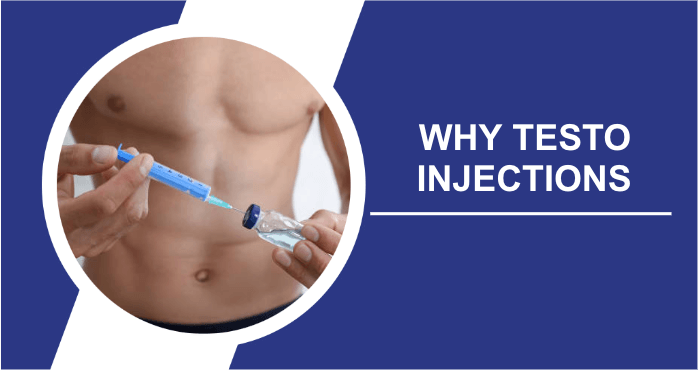Nowadays, men face the issue of having lower testosterone levels, which leads to decreased strength and vitality when compared to previous generations. To address this problem, one standard method is the administration of injections, a procedure aimed at replenishing hormone levels. Testosterone injections are hormone treatments for sexual dysfunction in males or postmenopausal symptoms in females with low testosterone. Keep reading to learn about all you need to know about testosterone injections.
Testosterone Deficiency in Men
In modern times, male testosterone levels have reached historically low levels, affecting strength and virility. Injecting testosterone into the muscle is a common approach to correcting this deficiency and restoring hormonal balance. Learn more about the importance of proper injection techniques to ensure effective treatment.
What Is Testosterone Actually?
Testosterone acts as the body’s energy regulator, overseeing processes such as muscle development, bone density, and even fluctuations in mood. The hormone contributes to the deepening of voices and hair growth during puberty, but its impact extends beyond that phase. Throughout life, it influences aspects such as confidence and libido, functioning as a subtle force that keeps us feeling strong and energized without realizing it.
What Is The Role Of Testosterone In Our Bodies?
Testosterone is the unsung hero of our bodies, orchestrating a symphony of physical and emotional changes. It’s the driving force behind muscle development, keeps our bones strong, and even affects our mood and cognition. During puberty, it’s like a conductor directing the transformation of boys into men, deepening voices and sprouting facial hair.
Once we reach adolescence, testosterone starts playing a role in our lives. It silently influences our confidence, motivation, and even our sexual desire. Consider it as the protector of our well being constantly working behind the scenes to ensure we remain both physically and emotionally strong and resilient.
Testosterone Injection Methods
Testosterone Replacement Therapy (TRT) offers a variety of injection methods to suit individual preferences, medical needs, and treatment plans. Here are the most common ones:
Intramuscular (IM) Injections
- Site of administration: Usually injected into the gluteal muscle (buttock) or thigh muscle.
- Frequency: Less frequently, usually every one to two weeks.
- Release rate: Provides sustained release of testosterone into the bloodstream, maintaining stable levels.
Subcutaneous Injection
- Site of administration: Injected into the layer of fat just under the skin.
- Frequency: Similar to intramuscular injections, administered every one to two weeks.
- Release rate: Provides a steady and consistent release of testosterone, similar to intramuscular injections.
Testosterone Cypionate Injections
- Formulation: Conventional injectable testosterone with a slower release rate.
- Frequency: Usually every 7 to 14 days.
- Benefits: Known for its stable and long-lasting effects, requiring less frequent injections.
Testosterone Enanthate Injections
- Formulation: Similar to cypionate, it is known for its longer-acting properties.
- Frequency: Usually every 7 to 14 days.
- Benefits: Provides sustained release of testosterone, requiring less frequent injections.
Testosterone Propionate Injections
- Formulation: Has a faster onset of action compared to cypionate and enanthate.
- Frequency: Requires more frequent injections, often every 1 to 3 days.
- Benefits: Allows for faster onset of action and precise control of testosterone levels.
Testosterone Undecanoate Injections
- Formulation: Comes in a long-acting formulation.
- Frequency: Administered less frequently, usually every 10 to 14 weeks.
- Benefits: Suitable for people who want less frequent injections and a longer duration of action.
Pellet Implants
- Administration: Testosterone pellets are implanted under the skin, usually in the hip or buttock area.
- Duration: Provides a slow and continuous release of testosterone over several months.
- Benefits: Eliminates the need for frequent injections and provides a convenient, long-term solution.
Why Choose Testosterone Injections?
Testosterone injections serve as a medical intervention that addresses testosterone deficiency and helps achieve optimal hormone balance. People choose testosterone injections, for reasons, including both medical and non-medical purposes.
- Correcting hormonal imbalances: Testosterone injections are a primary means of correcting hormonal imbalances, particularly in individuals suffering from testosterone deficiency. This deficiency can lead to several health problems, including fatigue, decreased libido, and loss of muscle mass.
- Anabolic effects: Athletes and bodybuilders often opt for testosterone injections to take advantage of its anabolic properties, which stimulate muscle protein synthesis, resulting in increased muscle growth and strength.
- Cognitive benefits: Testosterone plays an important role in cognitive function. Injection therapies combat cognitive decline associated with low testosterone levels, thereby improving mental clarity and concentration.
- Revitalising sexual health: Injections can revitalize libido, improve erectile function, and address issues related to sexual performance.
- Boost energy levels: Low testosterone levels are often associated with fatigue and mood swings. Testosterone injections can increase energy levels, reduce fatigue, and stabilize mood.
- Bone health: Testosterone helps to build bone density. Injections prevent osteoporosis and maintain skeletal health, especially in aging individuals prone to bone-related problems.
- Medical applications: In addition to treating testosterone deficiency, injections are used to treat certain medical conditions such as delayed puberty, certain forms of anemia, and breast cancer in women.
Which Is Better: Intramuscular Or Subcutaneous Injections
When deciding between subcutaneous testosterone injections for testosterone replacement therapy (TRT) there are several factors to consider, such as patient preference, medical considerations, and therapeutic goals. Let’s compare the two methods:
Administration Site
- Intramuscular testosterone injections: Administered deep into muscle tissue, usually in the gluteal (buttock) or thigh muscles.
- Subcutaneous injections: Injected into the fatty tissue just under the skin.
Needle Size And Depth
- Intramuscular testosterone injections: Usually require a longer needle to reach the muscle.
- Subcutaneous testosterone injections: Often uses a shorter, smaller needle because it doesn’t have to go deep into the muscle.
Frequency Of Injections
- Intramuscular injections: Administered less frequently, usually every one to two weeks.
- Subcutaneous injections: Similar to IM, usually every one to two weeks.
Release Rate And Stability
- Intramuscular injections: Provide a sustained release of testosterone into the bloodstream, maintaining stable levels.
- Subcutaneous injections: Provide a steady and consistent release of testosterone, similar to IM injections.
Pain And Discomfort
- Intramuscular injections: Some people may experience discomfort due to the deeper injection into muscle tissue.
- Subcutaneous injections: Generally associated with less pain as the injection is made into the fatty layer under the skin.
Absorption Rate
- Intramuscular injections: Testosterone is absorbed relatively quickly into the bloodstream.
- Subcutaneous injections: The absorption rate is slightly slower than IM but still effective.
Individual Preferences
- Intramuscular injections: Preferred by people who are used to or comfortable with deeper injections.
- Subcutaneous injections: Preferred by those seeking a less invasive injection method.
Adjustability And Precision
- Intramuscular injections: May allow more precise control of dosage adjustments.
- Subcutaneous injections: Offer flexibility and ease of dose adjustment.
What Happens If The Testosterone Is Not Injected Into The Muscle?
When testosterone is administered improperly and does not reach the intended muscle, various complications may arise. These include the risks of damaging blood vessels and nerves and the chance of developing an infection at the injection site. Here are the important things to remember:
- Damage to blood vessels and nerves: Incorrect injections can cause the needle to puncture blood vessels, resulting in the formation of a hematoma – an accumulation of blood that causes swelling, pain, and discoloration.
- Nerve injury: Accidental nerve puncture can damage the nerve, causing tingling, numbness, or weakness in the affected area.
- Risk of infection: Introduction of bacteria: If the injection bypasses the muscle and enters the surrounding tissue, there is an increased risk of introducing bacteria into the area, potentially leading to localized infections.
- Cellulitis: Infections in the subcutaneous tissue can lead to cellulitis, a bacterial skin infection characterized by redness, swelling, and warmth at the injection site.
- Localized inflammation and pain: The body’s inflammatory response to an incorrectly placed injection can cause pain, redness, and swelling at the injection site.
- Absorption rate: Injections that miss the muscle can alter the absorption rate of the injected substance, affecting the effectiveness of the medication and possibly causing hormone-level imbalances.
Injecting Testosterone Directly Into The Bloodstream
Injecting testosterone directly into the bloodstream is not a used or advised way of administering it. However, if testosterone is mistakenly injected directly into the bloodstream, there are potential issues that may arise:
- Rapid absorption: Direct injection into the bloodstream would result in rapid absorption of testosterone, causing an immediate spike in hormone levels.
- Uncontrolled hormone levels: Rapid increases in testosterone levels can lead to hormonal imbalances, potentially causing side effects such as mood swings, acne, or aggression.
- Cardiovascular effects: Elevated testosterone levels can have cardiovascular effects, affecting blood pressure and increasing the risk of cardiovascular events.
- Liver metabolic bypass: Testosterone injected into the bloodstream may bypass the liver’s metabolic processes, potentially affecting liver workload and function.
- Increased risk of side effects: The risk of side effects and complications may be higher when testosterone is injected directly into the bloodstream.
- Potential health risks: There are risks associated with injecting substances directly into the bloodstream, including the possibility of infection, embolism, or other serious complications.
Safe Testosterone Injection
Ensuring safety while administering testosterone injections is crucial, for achieving the outcomes and reducing any potential risks. Please adhere to the following guidelines:
- Sterile environment: Maintain a sterile and hygienic environment. Wash your hands thoroughly and use sterile equipment, including needles and vials.
- Appropriate needle size: Choose the correct needle size for intramuscular injections. Use thicker needles (22-25 gauge) for drawing up testosterone and slightly thinner needles (25-27 gauge) for the actual injection.
- Injection site: Target larger muscle groups such as the gluteal muscles or outer thigh. Rotate the injection sites to avoid damaging surrounding tissue.
- Aspiration: Before injecting, aspirate by gently pulling back on the syringe plunger to check that the needle is not in a blood vessel. If blood is observed, reposition the needle.
- Injection speed: Administer the injection slowly to minimize discomfort and reduce the risk of tissue trauma.
- Posti-injection massage: Gently massage the injection site after injection to enhance absorption and reduce potential discomfort.
- Proper sharps disposal: Dispose of needles and syringes in a puncture-resistant container according to local regulations. Do not attempt to recapper needles.
- Ongoing monitoring and follow-up: Continue to monitor the injection site for signs of infection, such as redness, swelling, or unusual pain. Seek medical advice if you have any concerns.
- Consult a healthcare professional: Always consult a healthcare professional for advice on injection technique, frequency, and dosage. Individual needs may vary, and professional guidance will ensure the safe and effective administration of testosterone.
Reduce Risk With Professional Administration
Opting for testosterone injections administered by a healthcare professional is a secure option compared to self-administration. Fountain TRT, a provider of testosterone replacement therapy, offers a convenient and reliable solution. Let’s take a look at what sets Fountain TRT:
- Online Doctor Visits: Fountain TRT offers online doctor visits to streamline the evaluation process. Men can receive a personalized assessment to determine whether TRT injections or a topical cream is better.
- Expert guidance: Founded by Dr. Doron Stember, a board-certified urologist with over a decade of experience, Fountain TRT ensures access to specialized evaluation and education, according to Fountain TRT reviews. Dr. Stember emphasizes the transformative impact of treating Low T on men’s lives.
- Low T Evaluation: Fountain TRT’s Low T assessment takes approximately two minutes, providing a quick and efficient way to begin the evaluation process.
- Topical cream alternative: Fountain TRT offers a topical cream as an alternative to injections, making treatment more accessible. This cream is applied every morning, providing a needle-free and hassle-free experience.
- Symptom relief: Fountain TRT addresses a wide range of symptoms associated with Low T, including increased body fat, fatigue, decreased sex drive, erectile dysfunction, decreased muscle mass, and more.
- Fast and convenient process: The TRT process with Fountain is quick, easy, and conducted online. It involves completing an assessment, taking a blood test, scheduling a video visit with a Fountain doctor, and receiving the prescribed treatment at your doorstep.
- Discreet delivery: Fountain TRT offers discreet and convenient delivery of testosterone treatment to your door each month. The topical cream applied to the shoulder area provides a needle-free solution.
- Comprehensive benefits: Whether by injection or topical cream, Fountain TRT helps men build muscle, lose excess fat, improve sexual function, enhance mental clarity and motivation, increase energy levels, and regain a sense of youth.
Choosing Fountain TRT, the best online TRT clinic means choosing a comprehensive, expert-led solution to Low T, accompanied by the convenience of online access and the choice of a topical cream for those who prefer to avoid injections.
Alternatives To Testosterone Injections
When exploring alternatives to testosterone replacement therapy (TRT) injections, there are options to take into account. These options include topical gels, buccal patches, and pellet implants. Transdermal patches stick to the skin. Gradually release testosterone. Although they ensure a release of testosterone, some individuals may encounter skin irritation.
Topical gels are applied to the skin and are absorbed by the body. They are easy to use, but there is a chance of accidentally transferring them to others. Buccal patches on the hand are placed on the gums as an alternative to applying them to the skin. However, they may cause gum irritation. Pellet implants involve inserting testosterone-containing pellets under the skin. They offer lasting effects but do require a minor surgical procedure.
How Can I Increase My Testosterone Levels Naturally?
Boosting testosterone levels naturally means adopting a healthy lifestyle. Regular exercise, especially strength training and high-intensity exercise can stimulate testosterone production. A balanced diet rich in nutrients such as zinc, vitamin D, and omega-3 fatty acids supports hormonal health. Adequate sleep and stress management are also important, as chronic stress can lead to testosterone decline.
Taking care of your weight and keeping your alcohol intake in check is also important for balance. Moreover, staying connected with others and participating in activities that bring you joy can boost your mood and confidence, which indirectly influences testosterone levels. By giving importance to these strategies, you can naturally enhance your body’s production of testosterone.
Are There Any Supplements To Increase Testosterone Levels?
Indeed, there are supplements that claim to enhance testosterone levels, but it’s crucial to approach them with caution as their effectiveness can vary. Some known choices include fenugreek, D-aspartic acid, and ashwagandha. However, it’s advisable to maintain an attitude toward these supplements and seek advice from a healthcare expert before incorporating them into your routine.
Lifestyle factors such as regular exercise, a balanced diet, and adequate sleep may significantly impact maintaining healthy testosterone levels. While supplements can provide some support, there’s no magic pill to boost testosterone. A holistic approach to overall health is often the most reliable strategy for maintaining hormonal balance.
Frequently Asked Questions
What are testosterone injections for, and why are they used?
Testosterone injections are a medical procedure where synthetic or bioidentical testosterone is injected into the body. This is primarily done to address conditions like hypogonadism, which occurs when the body does not naturally produce testosterone.
How can I determine if I need testosterone injections?
It is advisable to consult a healthcare professional who can assess your symptoms and perform blood tests to determine if you have low testosterone levels. Common signs of low testosterone include fatigue, decreased libido, muscle weakness, and mood changes.
Are there alternatives to testosterone injections to boost testosterone levels?
Options include testosterone gels, patches, and oral medication. Your decision will depend on your preferences, medical background, and the guidance provided by your healthcare professional.
Are testosterone injections considered safe?
In general, testosterone injections are considered safe when given under the supervision of a healthcare professional. However, they can cause adverse effects and should only be used under the supervision of a healthcare professional.
What are the possible side effects of testosterone injections?
Possible side effects of this medication include acne, mood changes, hair loss, an increase in the number of blood cells, and, in certain instances, potential risks to cardiovascular health. To minimize these risks, your doctor or healthcare provider will carefully monitor your treatment.
Final Thoughts
Finally, it’s important to avoid skipping testosterone injections, as this can lead to severe complications. To ensure the safety and effectiveness of your TRT treatments, we strongly recommend that you either seek the assistance of a medical professional for your injections or explore alternative methods.
Among the top online TRT clinics, our first choice is FountainTRT. Fountain TRT offers a comprehensive service, complete with a topical cream that eliminates the need for injections.
Sources
- Testosterone replacement therapy and cardiovascular disease. DOI: 10.1038/s41443-021-00516-6 Read more
- Effects of Testosterone Supplementation for 3 Years on Muscle Performance and Physical Function in Older Men. DOI: 10.1210/jc.2016-2771 Read more
- Medicinal Use of Testosterone and Related Steroids Revisited. DOI: 10.3390/molecules26041032 Read more
- Testosterone supplementation. DOI: 10.1016 Read more
Mark Willson, holding a Ph.D., functions as a psychotherapist in Washington, D.C. His specialized fields encompass addiction, anxiety, depression, as well as sexuality and interpersonal connections. Dr. Willson holds the distinction of being a diplomat for the American Board of Addiction and Anxiety, further serving as a certified counselor and addiction specialist.
Aside from his personal professional endeavors, Dr. Wilson has engaged in roles as an author, journalist, and creator within substantial medical documentary projects.
Isabella Clark, Ph.D., held the position of a professor within Emory University’s School of Medicine, working in the Department of Mental Health and Nutrition Science. Alongside this role, she served as a research associate affiliated with the National Research Center. Dr. Clark’s primary area of research centers on comprehending the mechanisms through which adverse social encounters, encompassing prolonged stress and traumatic exposure, contribute to a spectrum of detrimental mental health consequences and coexisting physical ailments like obesity. Her specific focus lies in unraveling the reasons behind the varying elevated susceptibility to stress-linked disorders between different genders.





